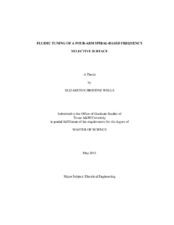| dc.contributor.advisor | Huff, Gregory | |
| dc.creator | Wells, Elizabeth Christine | |
| dc.date.accessioned | 2011-08-08T22:48:40Z | |
| dc.date.accessioned | 2011-08-09T01:32:43Z | |
| dc.date.available | 2011-08-08T22:48:40Z | |
| dc.date.available | 2011-08-09T01:32:43Z | |
| dc.date.created | 2011-05 | |
| dc.date.issued | 2011-08-08 | |
| dc.date.submitted | May 2011 | |
| dc.identifier.uri | https://hdl.handle.net/1969.1/ETD-TAMU-2011-05-9403 | |
| dc.description.abstract | Frequency selective surfaces (FSSs) provide a variety of spatial filtering functions, such as band-pass or band-stop properties in a radome or other multilayer structure. This filtering is typically achieved through closely-spaced periodic arrangements of metallic shapes on top of a dielectric substrate (or within a stack of dielectric materials). In most cases, the unit cell size, its shape, the substrate parameters, and the inter-element spacing collectively impact the response of the FSS. Expanding this design space to include reconfigurable FSSs provides opportunities for applications requiring frequency agility and/or other properties. Tuning can also enable operation over a potentially wider range of frequencies and can in some cases be used as a loading mechanism or quasi-ground plane. Many technologies have been considered for this type of agility (RF MEMS, PIN diodes, etc.). This includes the recent use of microfluidics and dispersions of nanoparticles, or fluids with controllable dielectrics, which have entered the design space of numerous other EM applications including stub-tuners, antennas, and filters. In this work they provide a material based approach to reconfiguring an FSS.
An FSS based on a four-arm spiral with tunable band-stop characteristics is presented in this work. A thin colloidal dispersion above each element provides this tuning capability. The radial expansion and contraction of this dispersion, as well as the variable permittivity of the dispersion, are used to load each element individually. This design incorporates thin fluidic channels within a PDMS layer below the substrate leading to individual unit cells that provide a closed pressure-driven subsystem that contains the dispersion. With the capability to individually control each cell, groups of cells can be locally altered (individually or in groups) to create gratings and other electromagnetically agile features across the surface or within the volume of a radome or other covering. Simulations and measurements of an S-band tunable design using colloidal Barium Strontium Titanate dispersed Silicone oil are provided to demonstrate the capability to adjust the stop-band characteristics of the FSS across the S-band. | en |
| dc.format.mimetype | application/pdf | |
| dc.language.iso | en_US | |
| dc.subject | FSS | en |
| dc.subject | Frequency Selective Surface | en |
| dc.subject | RF | en |
| dc.subject | Radio Frequency | en |
| dc.subject | BSTO | en |
| dc.subject | Barium Strontium Titanate Oxide | en |
| dc.subject | Si | en |
| dc.subject | Silicone | en |
| dc.subject | PDMS | en |
| dc.subject | Polydimethylsiloxane | en |
| dc.subject | φ | en |
| dc.subject | Volume Fraction | en |
| dc.subject | ε | en |
| dc.subject | Permittivity | en |
| dc.subject | dB | en |
| dc.subject | Decibels | en |
| dc.subject | GHz | en |
| dc.subject | Gigahertz | en |
| dc.subject | Freq | en |
| dc.subject | Frequency | en |
| dc.subject | S12 | en |
| dc.subject | Reverse Voltage Gain or Transmission | en |
| dc.subject | IL | en |
| dc.subject | Insertion Loss | en |
| dc.title | Fluidic Tuning of a Four-Arm Spiral-Based Frequency Selective Surface | en |
| dc.type | Thesis | en |
| thesis.degree.department | Electrical and Computer Engineering | en |
| thesis.degree.discipline | Electrical Engineering | en |
| thesis.degree.grantor | Texas A&M University | en |
| thesis.degree.name | Master of Science | en |
| thesis.degree.level | Masters | en |
| dc.contributor.committeeMember | Han, Arum | |
| dc.contributor.committeeMember | Chamberland, Jean-Francois | |
| dc.contributor.committeeMember | Michalski, Krzysztof | |
| dc.type.genre | thesis | en |
| dc.type.material | text | en |


